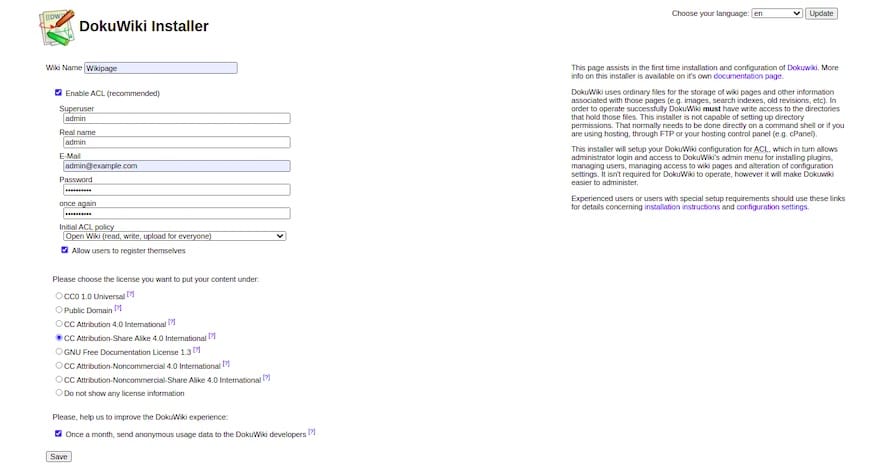How To Install DokuWiki on Rocky Linux 9

In this tutorial, we will show you how to install DokuWiki on Rocky Linux 9. Are you looking for powerful and customizable wiki software to create and maintain documentation? Look no further than DokuWiki – the open-source wiki software that is easy to install and highly flexible. With a wide range of plugins and extensions, you can customize your wiki to fit your needs. In this guide, we’ll walk you through the process of installing and configuring DokuWiki on a Rocky Linux 9 server. So, whether you’re a seasoned IT professional or just getting started, let’s dive in and get started with DokuWiki!
This article assumes you have at least basic knowledge of Linux, know how to use the shell, and most importantly, you host your site on your own VPS. The installation is quite simple and assumes you are running in the root account, if not you may need to add ‘sudo‘ to the commands to get root privileges. I will show you the step-by-step installation of the DokuWiki on Rocky Linux. 9.
Prerequisites
- A server running one of the following operating systems: Rocky Linux 9.
- It’s recommended that you use a fresh OS install to prevent any potential issues.
- SSH access to the server (or just open Terminal if you’re on a desktop).
- An active internet connection. You’ll need an internet connection to download the necessary packages and dependencies for DokuWiki.
- A
non-root sudo useror access to theroot user. We recommend acting as anon-root sudo user, however, as you can harm your system if you’re not careful when acting as the root.
Install DokuWiki on Rocky Linux 9
Step 1. The first step is to update your system to the latest version of the package list. To do so, run the following commands:
sudo dnf check-update sudo dnf install dnf-utils epel-release mod_ssl
Step 2. Installing Apache.
By default, Apache is available on the Rocky Linux 9 base repository. Now we install the latest version of Apache using dnf the command:
sudo dnf install httpd httpd-tools
You can start the httpd service and configure it to run on startup by entering the following commands:
sudo systemctl start httpd sudo systemctl enable httpd sudo systemctl status httpd
To make your pages available to the public, you will have to edit your firewall rules to allow HTTP and HTTPS requests on your web server by using the following commands:
sudo firewall-cmd --permanent --zone=public --add-service=http sudo firewall-cmd --permanent --zone=public --add-service=https sudo firewall-cmd --reload
For additional resources on installing Apache, read the post below:
Step 3. Installing PHP.
PHP is a popular scripting language that powers the dynamic content of millions of websites and apps. Now we run the commands below to install PHP 8 to your Rocky Linux:
sudo dnf epel-release sudo dnf install https://rpms.remirepo.net/enterprise/remi-release-9.rpm sudo dnf --disablerepo="*" --enablerepo="remi-safe" list available sudo dnf module enable php:remi-8.1
Once Remi PHP 8.1 module is enabled, you can now install PHP 8.1 and commonly used PHP extensions as follows:
sudo dnf install php php-cli php-mysqlnd php-opcache php-xml php-gd php-pdo php-bcmath php-intl php-mbstring php-json php-zip unzip
Check and verify the installed version:
php -v
For additional resources on installing PHP, read the post below:
Step 4. Installing DokuWiki on Rocky Linux 9.
Now download the latest version of the DokuWiki package from the official DokuWiki website using the following command:
wget https://download.dokuwiki.org/src/dokuwiki/dokuwiki-stable.tgz
Extract the archive using the following command:
sudo tar xf dokuwiki-stable.tgz -C /var/www/html/ sudo mv /var/www/html/dokuwiki-*/ /var/www/html/dokuwiki/
Next, we need to configure the permissions for the DokuWiki files. Run the following commands:
sudo mkdir /var/www/html/dokuwiki/data sudo chown -R apache:apache /var/www/html/dokuwiki
Step 5. Configuring Apache.
Now create a new virtual host for DokuWiki by creating a new Apache configuration file:
nano /etc/httpd/conf.d/dokuwiki.conf
Add the following file:
<VirtualHost *>
ServerName your-domain.com
DocumentRoot /var/www/html/dokuwiki
<Directory ~ "/var/www/html/dokuwiki/(bin/|conf/|data/|inc/)">
<IfModule mod_authz_core.c>
AllowOverride All
Require all denied
</IfModule>
<IfModule !mod_authz_core.c>
Order allow,deny
Deny from all
</IfModule>
</Directory>
ErrorLog /var/log/httpd/dokuwiki_error.log
CustomLog /var/log/httpd/dokuwiki_access.log combined
</VirtualHost>
Save and close the file, then restart the Apache web server for the changes to take effect:
sudo systemctl restart httpd
Step 6. Configure SELinux.
If SELinux is running, you need to run the commands below to configure SELinux to allow various accesses for DokuWiki:
sudo semanage fcontext -a -t httpd_sys_rw_content_t "/var/www/html/dokuwiki/conf(/.*)?" sudo restorecon -Rv /var/www/html/dokuwiki/conf sudo restorecon -Rv /var/www/html/dokuwiki/data sudo setsebool -P httpd_can_network_connect on sudo setsebool -P httpd_can_sendmail on sudo setsebool -P httpd_unified 1 sudo semanage fcontext -a -t httpd_sys_rw_content_t "/var/www/html/dokuwiki/lib/plugins(/.*)?" sudo restorecon -Rv /var/www/wiki/lib/plugins sudo semanage fcontext -a -t httpd_sys_rw_content_t "/var/www/html/dokuwiki/lib/tpl(/.*)?" sudo restorecon -Rv /var/www/html/dokuwiki/lib/tpl
Step 7. Secure DokuWiki with Let’s Encrypt SSL.
By default, DokuWiki does not use HTTPS, which means that all data transmitted between the server and the client is sent in plaintext. To enable HTTPS, you will need to install an SSL certificate and configure your web server to use it.
First, install the Certbot client using the following command below:
sudo dnf install certbot python3-certbot-apache
Then, run the following command to generate certificates with Apache:
sudo certbot --apache
Let’s Encrypt certificates have 90 days of validity, and it is highly advisable to renew the certificates before they expire. You can test automatic renewal for your certificates by running this command:
sudo certbot renew --dry-run
Step 8. Accessing DokuWiki Web Interface.
Once successfully installed, open your web browser and access DokuWiki using the URL https://your-domain.com/install.php. You will be redirected to the following page:

Congratulations! You have successfully installed DokuWiki. Thanks for using this tutorial for installing DokuWiki on your Rocky Linux 9 system. For additional help or useful information, we recommend you check the official DokuWiki website.